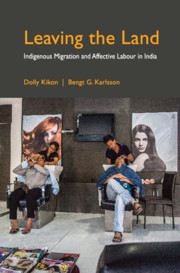4 - Interlude: Photoethnography
Published online by Cambridge University Press: 04 May 2019
Summary
It is possible, for example, however roughly, to describe the way somebody walks, but it is impossible to say anything about that fraction of a second when a person starts to walk. Photography with its various aids (lenses, enlargements) can reveal this moment.
– Walter Benjamin, A Short History of Photography, 1972At what moment do you become a migrant? When does a journey away from home begin? Some of our interlocutors told us that they wanted to go out to study or work from an early age, whereas for others it seemed to have happened out of a whim, a decision in the spur of a moment. Many just dreamt about setting out on such a journey. But more or less all those we talked to knew someone – a friend, a relative, or a neighbour – who had gone out and now lived in the big cities of the Indian mainland. In addition, as numbers of migrants increase, more of those who stay home are also drawn in to and participate in the new migratory culture where their lifeworld encompasses sensory experiences from work in five-star hotels, beauty parlours, or spas in distant megacities like Mumbai and Thiruvananthapuram.
Early on in the project we felt that we wanted to bring some kind of visual element into the research. Just think of the landscape, the contrast between the green, rolling hills dotted with villages and jhum fields that the migrants have left behind in the Northeast, and the metropolitan cityscape with fashionable designer interiors in hotels and spas where they now work in the south. The service industry is also about looks: Having the right appearance, being the face of the company, as discussed in Chapter 2. All this, it seemed, called for images. Photography can also, as Walter Benjamin suggests, capture a transitory moment: a particular expression, a passing sentiment, or a feeling (1972). More generally, we both appreciate photography and were inspired by anthropologists who incorporate images, for example, the work by Joao Biehl who collaborated with photographer Torben Eskerod (2005, 2007) and Fillip de Boek who worked with Marie-Francoise Plissart (2004), and that of anthropologists who themselves are skilful photographers, like Rebecca Empson (2011) and Jeffrey Schonberg (Bourgois and Schonberg 2009).
- Type
- Chapter
- Information
- Leaving the LandIndigenous Migration and Affective Labour in India, pp. 83 - 96Publisher: Cambridge University PressPrint publication year: 2019

